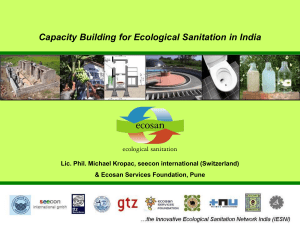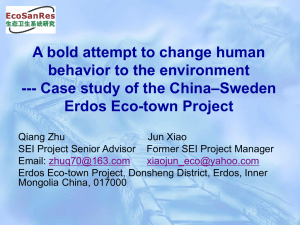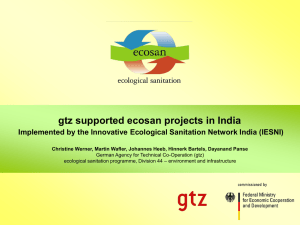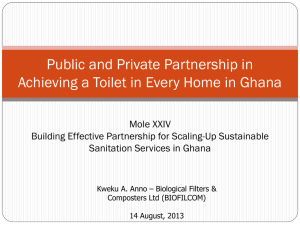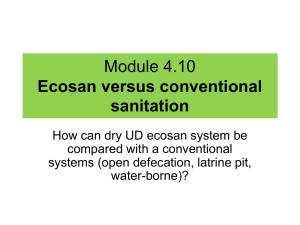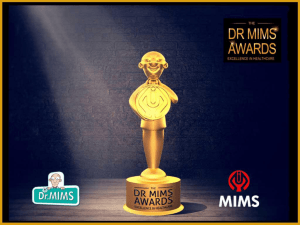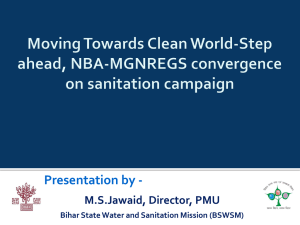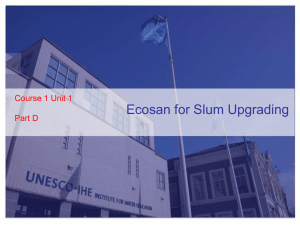Report on the status of the EcoSan Promotion Project facilities built
advertisement
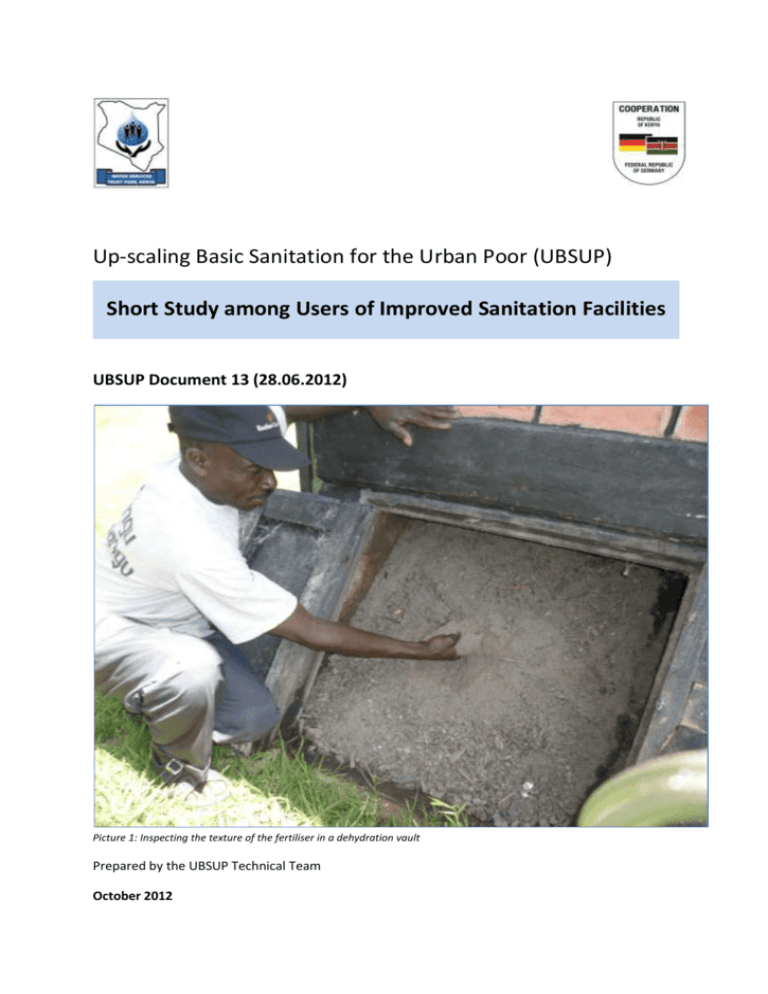
Up-scaling Basic Sanitation for the Urban Poor (UBSUP) Short Study among Users of Improved Sanitation Facilities UBSUP Document 13 (28.06.2012) Picture 1: Inspecting the texture of the fertiliser in a dehydration vault Prepared by the UBSUP Technical Team October 2012 1 Introduction The EcoSan Promotion Project (EPP) was a project component of the GIZ Water Sector Reform Program in Kenya and co-funded by the European Union, SIDA and GIZ. It worked in close partnership with the Ministry of Water and Irrigation (Maji House). During the project period (November 2006 - June 2010) 804 double vault Urine Diverting Dehydrating Toilets (UDDTs) and 13 Decentralised Treatment Systems (DTS) were installed. 541 UDDTs were built in households and 263 in institutions. In total, there were 51,600 beneficiaries. Many engineers, artisans and professional companies were trained in the sensitisation, planning and the construction of the EcoSan facilities. The project’s aim was to develop, test and promote the Ecological Sanitation concept including development of technical designs for large and small-scale sanitation projects in Kenya. The project focused on rural household and school based sanitation but also implemented toilets on public places like bus stations and institutions like prisons. On the 19th June 2012 to 28th June 2012, we visited 53 EcoSan facilities on a household level. Below you will find our results highlighting the positive outcomes as well as the challenges. Picture 2: Double vault UDDT Picture 3: Inside a UDDT d WSTF/GIZ/UBSUP Study among Users of Improved Sanitation October 2012 2 Fieldwork and Main Outcomes of the Study Day 1 5 household facilities visited in Kendu Bay Town, County Homabay. Area names are West Kenya Luo, Kamenya North (2), East Kenya Luo, Kanyadhiang 5 out of 5 facilities working well All 5 facilities were working well and the beneficiaries spoke positively about their EcoSan toilets. The people were sensitised well in this area by Wycliffe Osumba (a former EPP employee). They used their fertiliser in the farms and knew the processes of dehydrating and sanitising the excreta. All the beneficiaries were happy to share their facilities with the others in their homestead so that they could get more waste in their toilets. They understood that human excreta were a resource. None of the beneficiaries dumped solid waste in the dehydration vaults. Most inquired whether the EcoSan promotion project will be up scaled. Picture 4: Right section of the maize received fertiliser from the beneficiary’s EcoSan facility in Kendu Bay All the beneficiaries visited in this area, had a hand washing facility which was currently in use. All instruction posters were intact in the EcoSan facilities that were visited in this area WSTF/GIZ/UBSUP Study among Users of Improved Sanitation October 2012 3 There were complaints regarding urine pipe blockages. The dehydration vaults were lined with wood which was susceptible to termites therefore the beneficiaries would have preferred to have alternative material like steel. One particular beneficiary mentioned that he had not been given the guideline on how to use the urine and the ratio of diluting it. The particular beneficiary also still had a pit latrine in his homestead. Day 2 5 EcoSan household facilities in Nyanza, County: Kisumu Town names are Sondu (2), Pap Onditi (3) 4 out of 5 facilities EcoSan facilities were working well All EcoSan facilities that we visited in this area are still equipped with hand washing facilities. Only one hand washing facility was not in use. The beneficiaries reused the fertiliser in their farms and accepted the EcoSan technology well. One beneficiary complained that the pipe for the rainwater harvesting is broken and some said that they would have wished to receive equipment for the removal and transportation of the fertiliser into the farm. Picture 5: Broken rainwater harvesting pipe Picture 6: Wooden urine chamber door eaten by termites Many said that the advantages were a cleaner environment, more manure, shared maintenance of the facility and urine collection for the farms. Disadvantages were poor maintenance of the facilities especially from people who did not know how to use them. In addition, all EcoSan instruction posters were intact here. One beneficiary who did not use the EcoSan facility in this area mentioned that her preferred toilet was the flush toilet. This particular beneficiary was obviously well off and had 8 toilets i.e. 4 pit latrines, 3 flush toilets and one EcoSan facility in her homestead. WSTF/GIZ/UBSUP Study among Users of Improved Sanitation October 2012 4 Day 3 10 EcoSan household facilities in Bungoma, Chwele 8 out of 10 EcoSan facilities were working well Area names: Namawanga, Kolani, Wanjoya, Butende, Chwele town, Lutaso, Chwele B, Sanandiki. 8 out of 10 facilities were in use and functioning well. 8 out of 10 beneficiaries said that the advantage of sharing the EcoSan toilet in their homestead is to get more fertiliser for their farms and they were aware of the procedures required for dehydration and sanitisation. 3 out of the 10 hand washing facilities were not in use. Problems were urine pipe blockages in four sanitation facilities. One beneficiary mentioned that they had problems with water entering their sanitation facility through the vent pipe during heavy rains. Equipments such as gumboots and wheelbarrows for transportation were also requested. All the facilities here were equipped with an EcoSan instruction poster. Picture 7: A functioning hand washing facility in Chwele, Bungoma WSTF/GIZ/UBSUP Picture 8: An EcoSan beneficiary using his hand washing facility Study among Users of Improved Sanitation October 2012 5 Day 4 5 EcoSan household facilities in Ugenya, Tingywangi 5 out of 5 facilities not in use We visited 5 EcoSan facilities in the area and none were appropriately used. In this particular cluster, it was clear to us that no sensitisation had taken place. None of the beneficiaries we visited seemed to understand the concept of the toilet and none of the excreta was used in the farm. They either did not use it or downgraded the EcoSan facility into a ventilated improved pit latrine. The first beneficiary, a lady tried to convince her husband about how to use the toilet. However the husband was not involved during the construction of the facility as he worked in Nakuru and came home 3 times a year. Once he saw the facility, he assumed that his wife had not understood how to use the toilet. He therefore connected the slab to pipes leading to a pit that he dug next to the toilet thus not separating the urine and faeces. The wife informed us that the husband was explained by a repairman on how to use the EcoSan toilet properly and now he plans to remove the pipe and use it as it was intended. (See picture 9 & 10) This particular problem can be attributed to gender inequalities and challenges of integrating a gender perspective in sustainable sanitation during the sensitisation phase. Picture 9: Male beneficiary was not sensitised. He inserted pipes in the dehydration chamber leading to an offset pit Picture 10: Section with the pit next to the dehydration vaults. The second beneficiary had two toilets, one EcoSan and one pit latrine. The EcoSan was not in use because the door had been stolen one and a half years ago. The third beneficiary used their toilet as a pit latrine saying that her preferred toilet was a pit latrine because it only had one hole. She said she had problems with people excreting in the urine section thus leading to difficulties in maintenance and furthermore did not see the benefits of the fertiliser. WSTF/GIZ/UBSUP Study among Users of Improved Sanitation October 2012 6 The fourth beneficiary mixed urine and faeces together and did not understand the aspect of using urine and faeces as a fertiliser. They preferred the flush toilet because the excreta is flushed and forgotten. It was worth noting that in this particular homestead, they had a bench UDDT because the father of the household was not able to squat and was unwell requiring a toilet that is in the house. However both EcoSan facilities were in a dilapidated state. Although having the appropriate facilities for EcoSan, the members of the household did not use the facilities appropriately. Picture 11: The UDDT used as a pit latrine Picture 12: UDDT was unfinished therefore pit latrine was used instead The fifth beneficiary used the pit latrine instead of the EcoSan toilet that was constructed in his homestead because he did not know how to use it and it was incomplete. There was no urine canister and no hole for the urine pipe entering the urine chamber. We could tell from communicating with him that he was not informed about how exactly he was supposed to use the toilet. Day 5 7 EcoSan in Western Kenya, Kakemega, Mumias 6 out of the 7 facilities were in use 6 out of 7 EcoSan facilities we visited were used well and appropriately in this area. The beneficiary who did not use it mentioned that she wanted to wait until the pit latrine is full. 6 people who were using it informed us that the advantage of the EcoSan toilets is the source of fertiliser. 5 out of 6 mentioned that there are no disadvantages of sharing the toilet. They were happy with it. One beneficiary mentioned that they only have problems when visitors come and don’t use it properly or don’t read the instruction poster well. Another beneficiary mentioned that poor maintenance is a problem. The most technical problem in this area was urine pipe blockage. In terms of hand washing facilities, only one was not in use. All the others were functioning and in use. WSTF/GIZ/UBSUP Study among Users of Improved Sanitation October 2012 7 Picture 13: Left: Fertiliser ready for the farm. Right: Dehydrating and sanitisation of the human excreta Day 6 We visited 7 EcoSan facilities in Province: Western Kenya, County: Siaya, Ugunja town 4 out of the 7 facilities were in use In this particular cluster in Ugunja, we visited 7 EcoSan facilities, 4 out of the 7 EcoSan facilities were used appropriately. The other three either used the EcoSan facility inappropriately e.g. used the dehydration chambers as pits. All beneficiaries apart from one mentioned that the main advantage of the toilet was due to the fertiliser. 4 beneficiaries mentioned that poor maintenance from users was a problem. This could be attributed to lack of appropriate knowledge on how to use the facilities. Unfortunately most of the EcoSan facilities in this area had no posters. It was unclear why this was the case. Only 3 out of the 7 original hand washing facilities that were constructed during the EPP in this area were functioning well. The section of the dehydration vaults that is made of wood was already being attacked by termites. WSTF/GIZ/UBSUP Study among Users of Improved Sanitation October 2012 8 Picture 14: Urine chamber used as a storage area Picture 15: Provision of leaves for wiping and ash in a UDDT Day 7 We visited 6 EcoSan facilities in Ugunja (3), Semenya (1), Ukwala (2) 4 out of the 6 facilities were in use The beneficiaries we visited in Ukwala used the sanitation facilities well both mentioning that the main advantage of sharing the EcoSan facility was the fertiliser. Both hand washing facilities in Ukwala were working well too. We saw one beneficiary in Semenya who mentioned that they only use the EcoSan toilet to defecate. Passing urine was done in the open and there were no hand washing facilities. One complained about the termites on the wooden section of the dehydration vaults. Only 1 out of 3 beneficiaries used the facility well in Ugunja however hand washing facilities were non-existent in the beneficiary households that we visited. Day 8 We visited 7 EcoSan facilities in Western Province, Siaya town 7 out of the 7 EcoSan facilities were in use 7 EcoSan facilities were visited in the area and all were in use. All the beneficiaries benefited from the EcoSan facilities. Only 2 out of 7 hand washing facilities were in use. For example instead of having the drum with water, one improvised and had a tippy tap instead. One beneficiary informed us that she and her husband were not able to squat and climb the stairs due to leg problems. However, the EcoSan facility was in good condition and all the other household WSTF/GIZ/UBSUP Study among Users of Improved Sanitation October 2012 9 members used the facility. The beneficiary said that she would like to use it however due to difficulties in climbing and squatting, this was impossible. Picture 16: Trees on the right were fertilised with urine, trees on the left had no fertiliser. All trees were grown at the same time Conclusion There is a need to upscale ecological sanitation facilities in rural areas due to the benefits reported above. In the areas where appropriate sensitisation and community mobilisation took place, there were no problems of misuse and acceptance. All the beneficiaries acknowledged that waste was a resource and was used for increasing their crop yields. They also informed us of the economical benefits of not having to buy fertiliser anymore and being able to spend this money on other purposes such as school fees. The problems were therefore primarily technical i.e. blockage of the urine pipe and wooden frames/doors of the dehydration chambers were eaten by termites. We saw very good technical and social results in areas where community mobilisation and sensitisation was carried out by Wycliffe Osumba and Moses Wakala (both former GIZ EPP employees). Moses and Wycliffe are popular in the areas that they worked in and are still accessible to the beneficiaries who received the household facilities. In addition, in an attempt to upscale EcoSan facilities in the area, Moses opened an EcoSan shop selling sanitary ware and EcoSan components and has since then constructed further facilities. Moses has personally constructed a further 10 household facilities and facilities in 5 schools. He has also sold 40 squatting pans to date. WSTF/GIZ/UBSUP Study among Users of Improved Sanitation October 2012 10 Picture 17: Ecosan shop in Bungoma owned by Moses Wakala In Ugenya, results were poor because there was a clear lack of sensitisation and public awareness creation. In addition, some of the toilets had not been finished and none of the beneficiaries could pin point the person who was in charge of sensitisation during the project. Many informed us they had not been sensitised at all. The areas with problems had nothing to do with the attitude of the people and lack of acceptance. It was a pure lack of information on how to use the sanitation facilities due to lack of appropriate sensitisation. All beneficiaries who used the EcoSan facilities appropriately informed us that there health has drastically improved. Other improvements that came along with improved sanitation were a cleaner environment and cleaner water. We are of the perception that monitoring and evaluation in all phases of the implementation is paramount in ensuring that sustainable operation and maintenance as well as sensitisation are achieved. Picture 18: Satisfied beneficiaries from Kendu Bay WSTF/GIZ/UBSUP Study among Users of Improved Sanitation October 2012 11 Quotes Positive comments regarding the toilets: “It is prestigious for me to own this toilet. Everyone in this area now knows my name because I own an EcoSan toilet” (Male beneficiary in Ugenya) Question: “Were you satisfied with your sanitation situation before you received the EcoSan toilet?” Answer: “What sanitation situation? We were going to the toilet behind the bush” (Female beneficiary in Siaya) “What is your favourite toilet?” “EcoSan” “Why?” “It is clean and odourless and is safe for my children. Pit latrines are constantly collapsing here which is dangerous. I can also use the fertiliser for my crops. I now don’t have to buy fertiliser for my crops anymore. I can use the money for my children’s school fees.” (Male beneficiary in Rachuonyo) “Dirty is a pit latrine but a UDDT is clean and contributes to cleanliness which is very important according to the Quran” (UDDT muslim beneficiary in Mumias) “My neighbours are jealous. They want to have a toilet like mine and are still quite upset that they were not considered.” (Female beneficiary in Mumias) Neighbour: “I’m jealous because I don’t have an ecosan toilet. My pit latrine has termites and my slab was eaten by termites.” (Male neighbour in Mumias) “Do you think your toilet is clean most of the time?” “Yes” “Do you think your toilet is clean at the moment?” “YES OFCOURSE! I would eat inside my toilet!” (Female beneficiary from Mumias) Critical comments: “I can’t squat anymore. I am old. Please provide me with a chair to sit.” (Female beneficiary in Siaya) “It is hard for me to climb the stairs especially at night. Rails would help.” (Female beneficiary in Kendu Bay) “Why were there so few people who benefited from the toilets? Why did you not assist everyone in the village? Our yields are not as good because we don’t have an EcoSan toilet.” (Male neighbour of an EcoSan beneficiary in Mumias) WSTF/GIZ/UBSUP Study among Users of Improved Sanitation October 2012 12 Picture 19: Communication with the beneficiaries WSTF/GIZ/UBSUP Study among Users of Improved Sanitation October 2012
